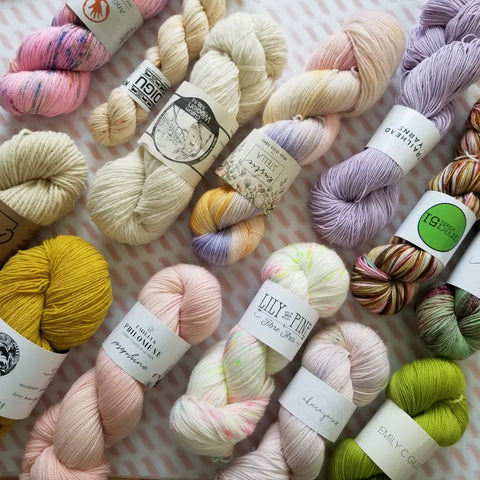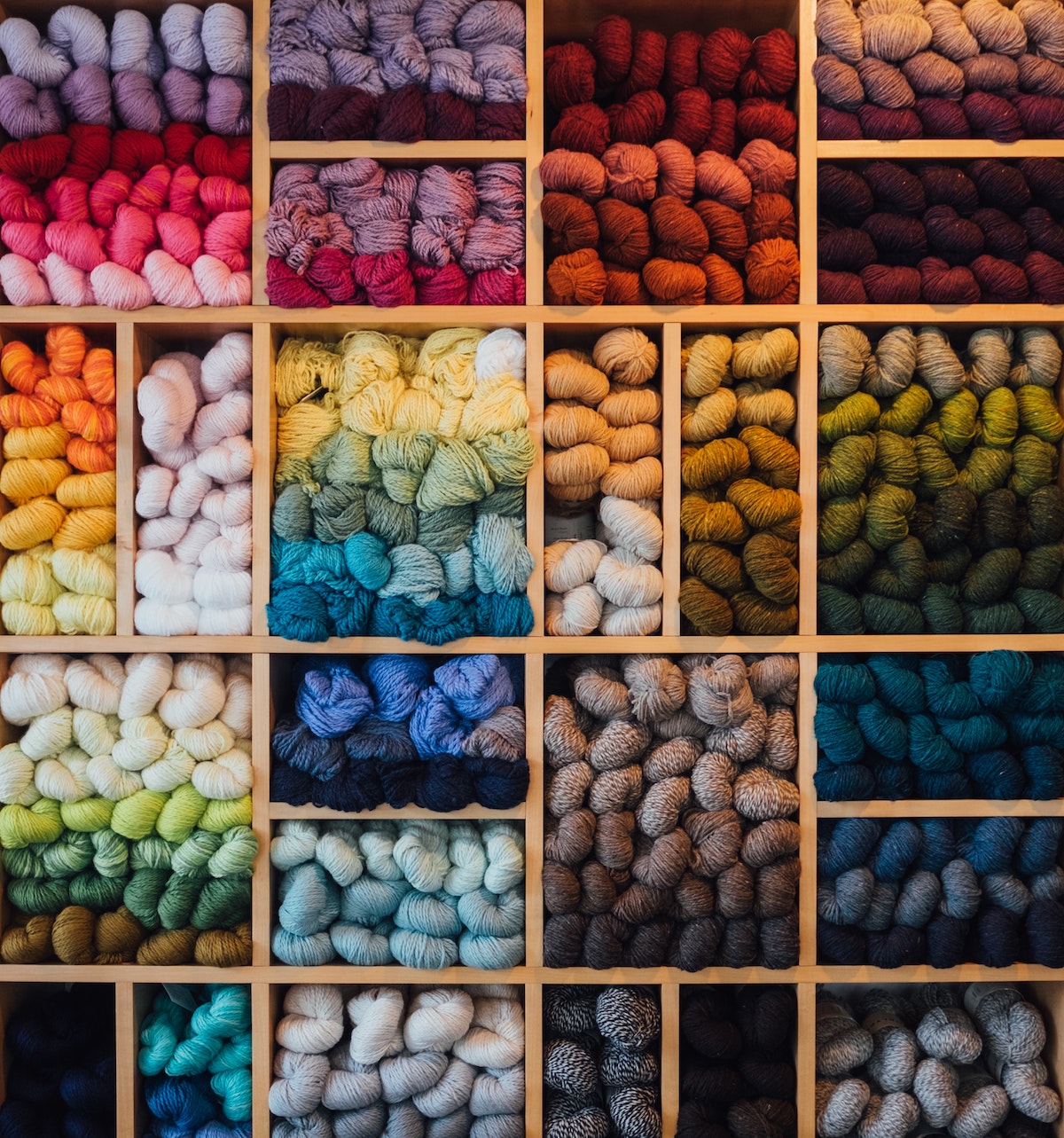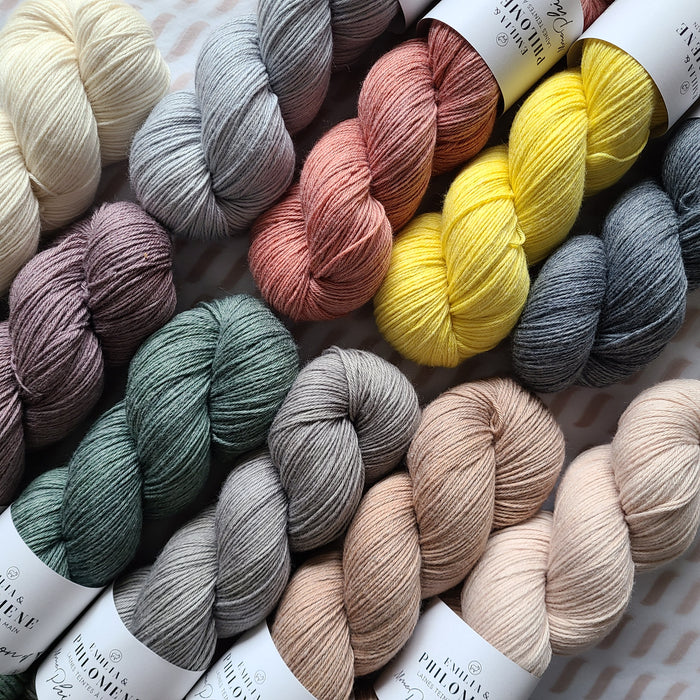
What You Will Learn In This Guide
It can be tough selecting the right yarn for your project. Not only are there numerous gorgeous colours to choose from, but there are many different types of fibres to choose from. The only thing we LOVE more than talking about yarn is helping people pick the perfect yarn for their next project. We have one important rules to follow to make sure you’re going to be happy with your finished work… FOLLOW THE FIBRE!
Each type of fibre behaves differently
Superwash yarn has been treated and coated to allow it the ability to be tossed in the washer. Unlike its counterpart, non-superwash wool, it is more ‘slippery’ than non-superwash yarn so using it in colourwork means the yarn fibres won’t ‘grip’ together as well as a wooly yarn. Our top tip for selecting yarn is to follow the fibre type that the pattern recommends as closely as possible. If you’ve fallen in love with a skein of cool cotton, and the pattern calls for wool, you can give it a go with wool but have realistic expectations - the finished object will have a different drape and feel than the pattern you fell in love with. We can help you find a project that fits for the yarn you’ve just gotta have. (We GET it, we’re crazy for yarn too) Or, if you’ve found a pattern for the perfect pair of mittens, we’ll find the right yarn for that project.

Knitting Terminology
Crafters sure use a lot of interesting words to talk about yarn. It can feel like another language! We’re here to help with some info on what the heck all these crafty words actually mean. This is by no means a complete list, so let us know if you’ve come across a word that isn’t here. We’ll add it to our list!
Heathered - Different colours and textures can be blended together in heathered yarn. The end result can be a softer, more muted colour.
Marled - Multiple, multicoloured yarns twisted together, creating a “marbled” appearance.
Variegated - This is yarn dyed with more than one colour. Some yarns can have a less distinct or more subtle variation than others.
Ombre - From the French term for “shaded”, this typically refers to a gradual colour change from light to dark, or one colour to another. Sometimes the yarn will do all the work for you to create this effect or you can create it on your own with the right colours.
Tweed - Yarn has a primary colour that is flecked with other colours, creating a speckled appearance.
Self Striping - As the name implies, this type of yarn creates stripes as you craft.
Fade - When colours flow from one to the next. This can be achieved by a slow transition between colours. Usually two colours will be alternated for several rows before the first colour is completely dropped from the project.

Yarn Weight
Yarn weight refers to the range thickness of the yarn. From lightest to heaviest:
Cobweb - Cobweb is 1ply yarn that is incredibly thin. This yarn can be tricky to find.
Lace - Also extremely thin and more common that cobwed. A popular way to add texture or interest to your projects is to hold a lace weight mohair or Suri Alpaca with another yarn to add warmth and texture.
Fingering (Sock) - As the name suggests, it is a common weight for socks but can also be used for sweaters, shawls, hats, mittens, baby items. (Heads up: Some yarn labeled sock isn’t great for socks. Make sure that you’re using yarn with some nylon or mohair in it to make socks. This will help your socks last way longer)
Sport - Sport weight is one of those inbetween weights - quite often you can substitute a sport weight for a light DK and vice versa. Before you start your project you will want to knit up a quick 4" x 4" gauge swatch!
DK (Double Knitting) - DK stands for Double Knitting weight. Popular for garments, it is lighter than worsted weight but heavier than fingering or sock weight.
Worsted - This falls in the middle. Great for sweaters, hats, mittens. Sometimes you’ll hear knitters say ‘light worsted’ which means that a yarn falls on the lighter, less bulky side of worsted yarn.
Aran - Heavier than worsted without being too bulky. Good for warm, thick hats and sweaters.
Bulky - Bulky is as the name implies. You’ll really notice the stitches in this yarn. It’s a great option for hats, blankets and warm winter mittens.
Super Bulky - This is the catchall for the thickest yarns. This is where we go to when we want to make a quick blanket or lovely thick scarf.
This is a lot to remember! So here’s a handy link that we love from Ravelry.

Yarn Fibre Dictionary
Acrylic Yarn
This mass-produced synthetic fibre is suitable for virtually any project. In addition to being colourfast, it is durable enough for machine washing and drying. It is lightweight, making it an excellent yarn for projects such as baby blankets, and because it can be more budget friendly than some other fibres, it is a great choice for crafts and crocheters just starting out.
Alpaca Yarn
Alpaca is named for the animal from whose fleece it is produced. Similar in appearance to llamas, alpacas are native to South America and their fleece is prized for the soft, warm yarn it produces. This is a wonderful choice for winter items. Another great feature of alpaca yarn is that it is naturally hypoallergenic, owing to the lack of lanolin in the alpaca’s fleece.
The drawbacks of alpaca are that it doesn’t have much memory and as a result, it doesn't always hold it's shape as well as wool does and must be gently washed by hand.
Angora
From the rabbit of the same name, Angora is tremendously soft and exceptionally fine, requiring it to be blended with other yarns such as wool or acrylic in order to maintain its shape and last longer. Like Alpaca, it is an excellent choice for winter items.
Angora may be hand washed in cold water, then laid flat indoors to dry. Alternately, it may be dry cleaned.
Bamboo Yarn
Many people are unaware of the number of uses for bamboo, including this yarn which is made from the plant’s inner fibres. Despite what you might think, the resulting yarn is quite soft; spun enough, it can be softer than even silk! It is also surprisingly long-lasting, with natural anti-bacterial properties. It is a multi-purpose fibre, but being light and airy, it is particularly well-suited to summer garments and light wraps. For proper care, consult the label.
Cashmere
Ah, Cashmere. Even the name sounds soft! One of the softest yarns that you will find, it is produced from the undercoat of Cashmere goats. This is the yarn for those with sensitive skin. Hypoallergenic and not the least bit itchy, Cashmere does have some disadvantages. Namely the fact that it is not as hardwearing as other yarns like wool, and it can be expensive.
The cost of Cashmere is owed to the fact that the goats cannot be shorn and must instead be combed by hand. It is labour-intensive and produces little fleece. Items made of Cashmere must be dry cleaned, making them harder to care for.
Cotton Yarn
Cotton is one of the oldest known materials and remains popular in knitting today, with production taking place worldwide, but particularly in China and India. Cotton is light and breathable, absorbent, and strong. It is a perfect choice for summer items, but it is available in a variety of thicknesses, making it very versatile.
Cotton yarn is useful for many projects, from clothing to dishcloths, potholders, and much more. It is durable and machine washable.
Llama Yarn
Although llamas are often used as beasts of burden, they are also sources of wool. Typically, their finer, inner coat is used for this purpose, though this is more expensive than the outer coat which is rougher, but more hardwearing.
Llama yarn is suitable for hardwearing clothes and accessories, though yarn from baby llamas can be used for softer items. As with Alpaca yarn, it has no lanolin, making it hypoallergenic.
Linen
Linen has been with us down through the centuries, originating before the ancient Egyptians. A fibre derived from the flax plant, linen is strong, cool, and breathable. Like cotton, it is quite absorbent, but it is faster to dry. Linen is comfortable to wear in hot weather, making it suitable for summer clothes as well as other household items, and is machine washable. It is somewhat pricey, owing to the difficulty of its creation.
Merino
This is a thick type of wool, sourced from a particular type of sheep, named, as you might guess, Merino. Originating in 12th century Spain, it found its way to Australia and New Zealand, resulting in modern Merino. Unlike other types of wool, it is hypoallergenic. It retains its shape well and is suitable for all types of projects.
Mohair
Prized for its softness and sheen, mohair is long lasting, breathable, and an excellent insulator, making it suitable for every season. Although derived from the Angora goat, it is not referred to as Angora—that name is reserved for yarn from the Angora rabbit.
Mohair is suitable for many uses, but certain individuals may suffer skin irritation from this fibre. We also don't recommend mohair for baby items as the fine fibres may find their way into eyes and mouths.
Novelty Yarn
This is a rather broad category that covers many specialty yarns, typically made of synthetic fibres.
Organic Yarn
This category isn’t a type of yarn and can refer to all types of fibres. The term organic refers instead to the way it is made. In the case of plant fibres, no pesticides will be used. Fibre are processed using gentle methods and using only soap and water to clean. While it is typically a little more expensive than other yarns of the same type, it benefits the environment.
Qiviut Yarn
Qiviut is naturally light chocolate-brown and is taken from the inner coat of the muskox. The word qiviut in Inuktitut can also refer to the down feathers of birds. Qiviut (pronounced kiv-ee-ute) is considered the warmest fibre in the world, making this luxurious fibre perhaps the best choice for cold-weather clothes. For proper care, see the label.
Rayon
A mix of natural and synthetic fibres, rayon comes from cellulose from re-used wood pulp, as well as other agricultural residue. Suitable for warm weather, it is smooth and light against the skin. It is a good alternative to linen when you are seeking something less expensive.
Proper care involves hand washing, but always refer to the instructions.
Silk Yarn
Silk comes in two varieties: spun silk and reeled silk. The former is the more expensive of the two, but both are among the more expensive fibres available.
Originating in China, silk is the product of the silkworm. It is a luxurious fibre that is soft and smooth, but very labour-intensive to create, hence the cost.
Silk is suitable for light crocheted items, including shawls and wraps. Although it is the strongest natural fibre, items made of silk should be washed gently by hand or dry cleaned.
T-Shirt Yarn
This unique yarn is made from recycled t-shirts, making it extremely eco-friendly. It is available in an assortment of colours and fibres, though cotton is the most common.
Wool
Wool consists of many varieties, but the three most common are:
Merino
Merino wool is a natural fiber grown from the sheep of the same name. Thinner and softer than regular wool, making it easy to wear next to skin.
Shetland
From hardy Scottish sheep dwelling on the Shetland Islands. Shetland wool is warm, strong, soft, durable and the finest any British sheep breed produces.
Icelandic
Wool of Icelandic sheep is special in that it has a combination of two different types of hair that serve as a natural barrier from wet and cold weather. The outer layer is composed of coarse, long hair known in Icelandic as tog. Underneath the tog, there is a layer of short hair, known in Icelandic as þel.
You will also likely hear of lamb wool, which is soft, fluffy wool from the first shearing, and pure or virgin wool, which refers to new animal fleece, not reused. Wool comes in four thicknesses: Fine, medium, long, and double, with the finer wool being softer and more delicate. It is also naturally fire-resistant, and it is insulating nature makes it cool in summer and warm in winter.
Wool is suitable for a very wide range of projects and all seasons. It has become a popular choice for crochet beginners. Some types of yarn may be machine washable, but always check the instructions!
Wool can be mixed with other fibre for specific purposes (for a pair of socks, you’ll want a bit of nylon, mohair, or silk included to make sure your toes stay inside the socks).
Care for wool blends is generally the same as for wool. Some blends include:
- Wool and nylon
- Merino wool and silk
- Cotton, acrylic, and wool
- Wool and cotton

Frequently Asked Questions About Yarn
What is Fingering Weight Yarn?
Typically called #2 or Super Fine yarn, it is also commonly referred to as Sock Yarn. Despite the name, if you are using sock yarn to make socks, be sure that you are using a yarn with either nylon or mohair for suitable durability.
What is the Difference Between Yarn and Wool?
Wool is actually a type of yarn. Yarn refers to the length of fibres used to create fabrics.
What is Worsted Yarn?
Worsted weight yarn is medium weight yarn.
There is also Worsted Spun yarn and this refers to the spinning technique used in the production of the yarn.
What is Yarn Made of?
Yarn is made from twisted strands of fibres of natural or synthetic origin.
How Do You Join Yarn?
We don't recommend trying knots in your knitting projects as knots are knotty and always find a way to poke throught to the front of your finished object. Instead, you may want to spit splice them if they are feltable yarns. We tend to knit until we have approximately 6 - 8 inches of yarn left on the first ball, drop the tail and simply begin knitting with the new ball. You will then go back and weave in the tails and close up any gaps. Remember, 'knots are knotty'!
Best practice is to always join your next ball of yarn at the beginning of a row, not in the middle of a row. If you are knitting in the round, we recommend adding in the second ball under the arm or on the side of the sweater.
What is DK Weight Yarn?
DK stands for Double Knitting yarn and is one of the most popular weights due to its versatility. It is heavier than Sport weight, but lighter than Worsted.
What Yarn is Made in Canada?
Yarn made in Canada is a specific brand name, as opposed to a type. If you are seeking a Canadian brand, a quick Google search for “yarn made in Canada” will point you in the right direction.
What Types of Yarn Are Best For Crochet?
The best yarn for beginners is whatever yarn keeps you wanting more! Some people prefer to use an affordable option like acrylic and some makers dive in head first into a lovely wool or wool blend. A good weight to work with is worsted weight. Truly, the best yarn is the one that keeps you motivated and that you enjoy working with.
What Types of Yarn Are Best For Knitting?
We are of the thought that there is no best yarn, no best needles and no best way to knit or crochet. There are best practices to follow when choosing yarn for a pattern and that being said, we suggest that if you are just starting out, you might want to start with a good quality acrylic, something that can withstand being ripped out a few times. We like Uptown Worsted, a great non-piling acrylic.
What is the Softest Yarn?
Cashmere is wonderfully soft, though its drawbacks include the price and the fact that it is not terribly durable.
What Are Wool Allergies?
Some people are allergic to lanolin, a substance found in wool. Allergies are typified by skin irritation, sneezing, congestion, and red, puffy eyes. Note, however, that true wool allergies are somewhat rare, and the reaction may be due to leftover dyes from the dying process.



